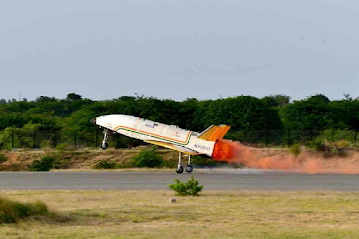The Indian Space Research Organization (ISRO) successfully carried out the third Reusable Launch Vehicle (RLV) Landing Experiment (LEX) on June 23 at the Aeronautical Test Range (ATR) in Chitradurga, Karnataka. This was a big step forward in space technology. As part of a larger attempt to make a fully reusable space vehicle, this project will change how people travel to space and how satellites are placed.
India’s space agency on Sunday conducted a third successful test flight of an experimental reusable launch vehicle (RLV), evaluating its endurance against more challenging wind conditions than it had encountered during its second test flight three months ago. The Indian Space Research Organisation said it had achieved “a third consecutive success” in a landing experiment with the RLV — a self-flying winged vehicle designed to execute missions in low Earth orbit and return to land like an aircraft
This mission simulated the approach and landing interface and high-speed landing conditions for a vehicle returning from space,” Isro said. The third RLV test flight reused the winged body and flight systems from the first test flight in April 2023 and the second test flight in March, demonstrating the vehicle’s capability to reuse flight systems for multiple missions.
The RLV named Pushpak executed cross-range correction manoeuvres, approached the runway, and performed a precise horizontal landing along the runway centreline, the agency said. Due to the RLV’s aerodynamic configuration, the landing speed exceeded 320kmph, compared to 260kmph for a typical commercial aircraft and 280kmph for a fighter aircraft.
After the touchdown, a brake parachute reduced the vehicle’s speed to 100kmph after which the landing gear brakes were activated for further deceleration. During this ground roll phase, Isro said, Pushpak uses its rudder and nose wheel steering system to maintain a stable and precise ground roll. Aerospace engineers say the RLV which combines the complexity of both launch vehicles and aircraft is intended to reduce the cost of launching satellites that have traditionally been ferried into space by single-use rockets.
Context and Objective
The experiment used a winged car called “Pushpak,” which was dropped from a Chinook helicopter of the Indian Air Force from a height of 4.5 km. The vehicle then found its way to an exact landing on the centerline of the runway, even though the conditions were tougher than in previous tests. The goal of this test, called LEX-03, was to show that ISRO can still do independent landings even when conditions are more difficult, like when there is a lot of cross-range and strong winds.
The experiment used a winged car called “Pushpak,” which was dropped from a Chinook helicopter of the Indian Air Force from a height of 4.5 km. The vehicle then found its way to an exact landing on the centerline of the runway, even though the conditions were tougher than in previous tests. The goal of this test, called LEX-03, was to show that ISRO can still do independent landings even when conditions are more difficult, like when there is a lot of cross-range and strong winds.
Technical Highlights and Achievements
During the test, important advances in aircraft technology were shown, such as:
During the test, important advances in aircraft technology were shown, such as:
Self-Navigation and Landing: Pushpak did cross-range correction maneuvers from a launching point 4.5 km away, showing improved guidance, navigation, and control systems.
High-Speed Landing: The vehicle landed at over 320 km/h, much faster than a regular airplane. This shows how difficult it is to make space-entry vehicles that are both aerodynamically and structurally.
High-Speed Landing: The vehicle landed at over 320 km/h, much faster than a regular airplane. This shows how difficult it is to make space-entry vehicles that are both aerodynamically and structurally.
Advanced Sensor Integration: The fact that inertial sensors, radar altimeters, and the NavIC could work together to make exact navigation and landing possible shows how advanced ISRO’s aerospace technology is.
Vehicle Recovery and Reusability:After landing, the vehicle showed good braking by using its brake parachute and landing gear brakes, which is important for reusability. Notably, the winged body and flying systems from the previous LEX-02 mission were used without any changes. This shows that the launch vehicle parts are durable and can be used again.
Vehicle Recovery and Reusability:After landing, the vehicle showed good braking by using its brake parachute and landing gear brakes, which is important for reusability. Notably, the winged body and flying systems from the previous LEX-02 mission were used without any changes. This shows that the launch vehicle parts are durable and can be used again.
Implications for Future Space Missions
The success of the RLV-LEX-03 is a big step toward the creation of the Reusable Launch Vehicle (RLV) technology, which will allow space missions to happen more often and for less money. The improvements in autonomous guiding algorithms and sensor fusion technology that were proven in this mission are very important for future Orbital Re-entry Missions, which need to have safe and accurate return paths.
The success of the RLV-LEX-03 is a big step toward the creation of the Reusable Launch Vehicle (RLV) technology, which will allow space missions to happen more often and for less money. The improvements in autonomous guiding algorithms and sensor fusion technology that were proven in this mission are very important for future Orbital Re-entry Missions, which need to have safe and accurate return paths.
Website Link: popularengineer.org
#isro
#reusablelaunchvehicle
#spaceexploration
#indiaspace
#techinnovation
#spacetechnology
#landingtest
#spaceflight
#indiaspaceprogram

No comments:
Post a Comment